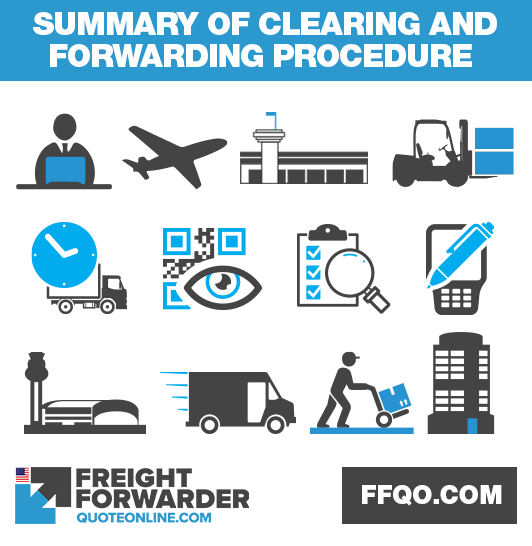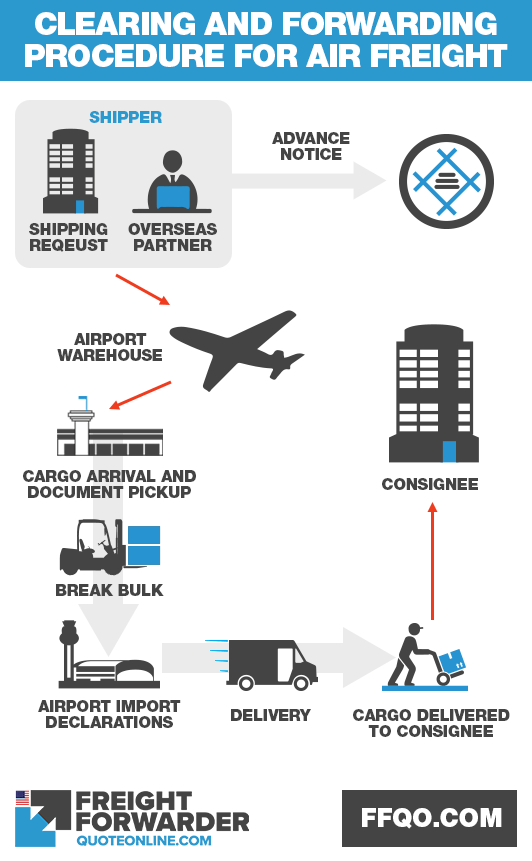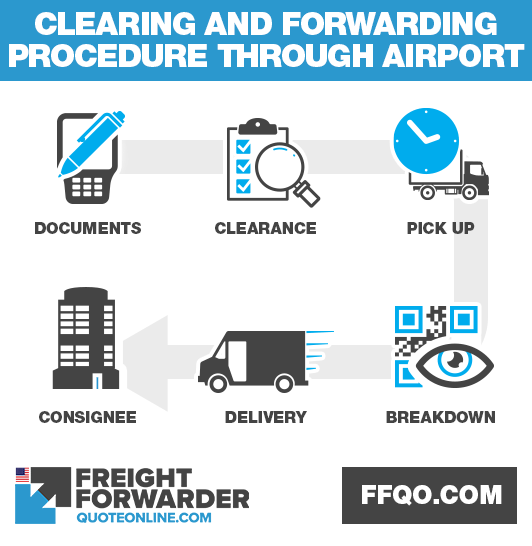Following on from our blog on the agent’s role in the air import procedure , we cover the clearing and forwarding procedure for import and export. This is the final part of our five-part series on our guide of the things to know when shipping with air freight.
Links to the other blogs in this series are as follows:
- What you have to know about air freight transit time
- Customer’s quest – How to find a freight forwarder
- Role of air freight forwarding company when importing
- Agent’s role in the air import procedure
Are you ready for the concluding part of this series? Read on.

Summary of clearing and forwarding procedure
Clearing and forwarding procedure starts with arrival of cargo
Now that your cargo has arrived at the airport of destination, it has to have all its importation documentation reviewed before it can be released. These documents include:
- Bill for the goods from the buyer to the seller
- Bill of lading – serves as contract between the owner of the goods and the carrier
- Certificate of origin – signed statement as to the origin of the imported item
- Packing list – itemized inventory of the goods in the shipment
- Power of Attorney – authorizes the freight forwarder to act on behalf of the owner
These documents, supplied by the handling agent, are transferred to the receiving freight forwarder. This transfer is done, either personally or through a third-party agent, upon arrival of the goods landside.
How customs is handled in the clearing and forwarding procedure
After the handling agent passes the documents to the receiving freight forwarder, it becomes their duty to have the cargo cleared through customs. The freight forwarder then works to complete the import processing. This includes supplying additional documentation or dealing with developments such as having to fumigate the cargo.
To make this process as efficient as possible, it is best to choose a freight forwarder that has certified customs brokers in-house. This will simplify management of any issues that may arise during the import process, as the number of third parties is reduced.
What happens during the clearing process of goods?
What actually happens during the customs clearance of goods? If you are new to importing this may be one of the things about which you are curious.
Air Cargo Advance Screening
Due to the increased dangers of illegal goods coming into the USA, the US Customs and Border Protection (CBP) and the Transportation Security Administration (TSA) have enhanced security in air cargo shipments through the Air Cargo Advance Screening (ACAS) project.
The procedure for Air Cargo Advance Screening has several major stages.
Collecting pre-loaded advance information
Through the “Trusted Shipper” concept, data supplied is used to pre-load information regarding the screening of incoming cargo. This includes criteria for shippers as well as air cargo shipments. It is based on the existing air cargo security directives and emergency amendments (SDs/EAs), such as:
- Shipper name and address
- Consignee name and address
- Cargo description
- Weight and piece count
Need more information on how you can find a trusted shipper? Talk to us today.
Enhancing risk-based targeting
Using the information the air cargo carrier and shipment provided, CBP and TSA analyzes this data against intelligence and other available historical data to identify shipments. This is done prior to loading so that if any threats are detected, the risks of damage to airport import facilities are minimized.
Streamline customs entry requirements
In parallel with ACAS, CBP uses additional data received through current trade filings. These improve the processing of ACAS shipment verification and release of import shipment.
Harmonization of International Air Cargo Security Standards
Further improvement of global security in airports when importing has been made through ACAS cooperating internationally with other countries. ACAS continually advocates for the global expansion of advanced data collection and submission on imports. This is to help enhance air cargo security worldwide.
Customs procedures of air cargo for import
Here is a brief overview of how customs procedures are handled by your customs broker.
Submission of documents prior to the arrival of the cargo
As mentioned earlier, documents such as commercial invoice, air waybill and packing list should be submitted prior to arrival of the goods at the destination airport. This makes for smooth preparation and cargo clearance process flow.
Coordination of documents via the customs broker
Upon acquiring all the required documents, the customs broker will now review these prior to entry of the goods. They will handle the notifications, filings and submissions to the carrier and customs. It is, however, of utmost importance for the importer to provide a duly signed Power of Attorney authorizing the broker to act on behalf of the owner of the goods.
Acquiring other documentations needed
Depending on the type of cargo to be imported, additional information may be required. Some of these government agencies requiring further inspection and certifications include:
- FDA – Food & Drug Administration
- FCC – Federal Communications Commission
- FWS – Fish & Wildlife Services
- DOT – Department of Transportation
- ATF – Alcohol, Tobacco and Firearms
- USDA – US Department of Agriculture
- CPSC – Consumer Product Safety Commission
Providing additional documentation for these agencies can be complex and result in significant delays in clearance. It is important to have an experienced customs broker who is prepared to help you with supplying whatever is needed to substantiate the requirement.
Payment of customs bond
CBP requires imported goods to have customs bonds. These are a guarantee from a surety company that the importer will abide by the laws and regulations governing the importation of merchandise into the United States.
The customs bond on imports depends on the value of goods to be imported. If the value of the goods is over $2,500, a customs bond needs to be paid that is relative to the value of goods to be imported. Shipments of value below $2,500 do not require a bond, but the importers will need to submit paperwork manually. In order to speed up importing of goods of value below $2,500, paying a customs bond will avoid the delay caused by manual submission.
To know more about customs bonds and if they are best for your imported shipment , feel free to call us.
How to expedite the clearing and forwarding procedure?
To ensure your cargo clears customs smoothly it is important to have on hand several key facts regarding the shipment. This will ensure you can immediately answer several types of common questions.
Know the total value of shipment
The worth of the items you are shipping and as per the commercial invoice.
Have detailed shipper contact information
Shipper contact details, including business addresses and emails.
Keep required identification on-hand
Depending on the total amount of your shipment, the identity of the person or company that is to collect the shipment may be required. If the shipment is for you personally, this will be some government-issued ID or passport. If the shipment is commercial, the company EIN number will be required.
Understand consignee to shipper relationship
A common customs (CBP) question is establishing the relationship of the consignee to the shipper. It is important for customers to know whether the goods are for the shipper or for the consignee.
When to include packing list
If the cargo is a commercial shipment, the commercial invoice can be submitted, instead of the packing list.
Make sure you sign where needed
Make sure you sign each and every instance within the various import documents. Have your customs broker double-check each document to make sure nothing is missed.
Be familiar with major steps in the clearing and forwarding procedure
To reduce your uncertainty when importing it is vital to be familiar with major steps in around clearing and forwarding procedures.

Major steps in import process around clearing and forwarding procedure
How air cargo imports are handled from airport to consignee
After the cargo has been cleared through customs, your goods will be picked-up from the handling agent and delivered to the forwarder’s warehouse. This may, however, vary depending on your agreement with the freight forwarder. How regular air cargo imports are handled from the landed airport to the consignee is summarized in five major steps.
Documentation pick-up at the airport
Upon arrival of the air cargo at the airport, documents will be picked up from the handling agent by the receiving forwarder. This is done through:
- Receiving a shipment alert from the airline
- Arrangement of local pick-up documents
Customs clearance for import
Before the goods can be properly released, they must first be cleared by the customs. This is by:
- Preparing customs documents
- Clearing cargo through customs
- Printing customs release note
Pick up goods at airport
Once the goods are cleared by customs, the receiving forwarder will now pick up the goods at the airport. Processes involved are:
- Arrangement of local pick-up of goods
- Pick-up of goods at the airport
Breakdown and sort
Once your cargo is in your forwarder’s custody, the shipment will be consolidated with others and made ready for transport. This is done through:
- Performing incoming checks
- Breaking down consolidations
- Sorting goods for connecting transport and load
Delivery to consignee
The transport of the shipment from the airport to the consignee is the final stage of the import process. The delivery is done via:
- Transport arrangement
- Preparation of transport documents
- Repacking and relabelling of goods as required
- Delivery to consignee
- Get proof of delivery (POD)
Now you’re an clearing and forwarding procedure expert
Great news! You’ve done it. We have completed the clearing and forwarding procedure for imported goods.

Clearing and forwarding procedure from airport to consignee
Need help on the clearing and forwarding procedure?
We offer a full range of air freight forwarding services. We are confident we can provide the help you need and answer any questions you may have about clearing and forwarding procedures.
Freight Forwarder Quote Online is able to give you the best prices as we have low overheads. If you are looking for air freight forwarding that is fast, lean and transparent, then contact us online online and send a message. You can even message us on message us for help on international shipping.
Answers to your questions on the clearing and forwarding procedure
Got any questions? Talk to us for any of your concerns regarding the clearing and forwarding procedure of your cargo. We are happy to answer them for you.




